2605ss02
2605ss02.docx
State Petitions for No-Discharge Zones (NDZs), Emergency Orders, Review of National Standards of Performance, and Enhanced Great Lakes System Requirements under CWA Section 312(p) (Final Rule)
OMB: 2040-0303
U.S. Environmental Protection Agency
Information Collection Request
Title: State Petitions for No-Discharge Zones (NDZs), Emergency Orders, Review of National Standards of Performance, and Enhanced Great Lakes System Requirements under Clean Water Act Section 312(p)
OMB Control Number: 2040-0303
EPA ICR Number: 2605.02
Abstract: Section 312(p) of the Clean Water Act (CWA) calls for EPA to promulgate national standards of performance for the control of discharges incidental to the normal operation of non-recreational, non-Armed Forces vessels, such as research and emergency rescue vessels, that are 79 feet in length and above, and ballast water only from small vessels (vessels less than 79 feet in length) and fishing vessels of all sizes – hereafter collectively referred to as “commercial vessels.”. This ICR is concerned with the procedures for states to petition EPA for more stringent standards. Following the promulgation of EPA standards, CWA section 312(p)(5) specifies that the U.S. Coast Guard (USCG) is to develop implementing regulations to ensure, monitor, and enforce compliance with the EPA standards. The USCG regulations are to be completed within two years of EPA promulgation of the national standards of performance. Information collection activities associated with those USCG regulations will be included as part of the USCG regulatory process. At such time, states and their political subdivisions will be preempted from adopting or enforcing any of their own statutes or regulations regarding these discharges.
Under CWA sections 312(p)(7) and 312(p)(10), however, there are four mechanisms through which states may petition EPA for more stringent discharge standards. For one, states may petition EPA to establish NDZs – a complete discharge prohibition for one or more discharges in some or all of a state’s waters. Second, states may petition EPA and the USCG to review any standard of performance, regulation, or policy (hereafter, “review of standards”) promulgated under CWA section 312(p) if there is new information that could reasonably result in a change to the standard, regulation, or policy. This information collection is limited to those petitions submitted to EPA for the review of any EPA standards of performance, regulation, or policy; petitions submitted to the USCG for a review of any USCG standards of performance, regulation, or policy will be considered as part of the USCG information collection activities described above. Third, states may petition EPA or the USCG for EPA to issue an order for the use of an emergency best management practice (“emergency order”) in instances where there is a risk related to either aquatic nuisance species or water quality violations. Lastly, Great Lakes states may jointly submit a petition to EPA and USCG endorsing a proposed standard of performance or other requirement with respect to any incidental discharge to apply within the Great Lakes System.
For EPA to effectively evaluate and respond to these petitions, the final rule requires states to provide information relevant to this decision-making process, thus triggering the requirement for EPA to have an ICR in compliance with the Paperwork Reduction Act. However, the regulatory petition procedures described herein do not apply until after the USCG regulations are effective. As such, EPA does not anticipate an information collection burden on states until such time as those USCG regulations are finalized and effective, which are specified to be completed within two years of EPA’s promulgation of national standards of performance. After that two-year timeframe, EPA is estimating one application for each of the first three different state petition activities – NDZs, review of standards, and emergency orders – in the third year of this three-year ICR cycle. The EPA is estimating zero applications for enhanced Great Lakes system requirements during this ICR cycle.
Supporting Statement A
1) Petition to establish an NDZ: In order for EPA to prohibit any discharge incidental to the normal operation of a vessel covered under the Vessel Incidental Discharge National Standards of Performance regulations (upon application by a state), EPA must make the following determinations: I) prohibition of the discharge would protect and enhance the quality of the specified waters within the state; 2) adequate facilities for the safe and sanitary removal and treatment of the discharge are reasonably available for the water and all vessels to which the prohibition would apply; and 3) the discharge can be safely collected and stored until a vessel reaches a discharge facility or other location. For applications related to ballast water in a port (or in any other location where cargo, passengers, or fuel are loaded and unloaded), in determining whether adequate facilities are available, EPA must consider water depth, dock size, pumpout facility capacity and flow rate, availability of year-round operations, proximity to navigation routes, and the ratio of pumpout facilities to the population and discharge capacity of commercial vessels operating in those waters. The EPA must also ensure that the prohibition of discharges of ballast water will not unreasonably interfere with the safe loading and unloading of cargo, passengers, or fuel (see CWA section 312(p)(10)(D)). The state must provide EPA relevant information, described in Section 4, to be able to make those determinations.
2) Petition for review of standards: A state may request that EPA and the USCG review any national standard of performance, regulation, or policy by submitting a petition which discusses significant new scientific and technical information that could reasonably result in a change to the standard, regulation, or policy, or any determination on which the standard of performance, regulation, or policy was based (see CWA section 312(p)(7)(A)(ii)). This information collection focuses just on those petitions requesting review of EPA standards. Petitions submitted for a review of USCG standards will be included as part of the USCG rulemaking described previously. The information provided by the state will assist EPA in the Agency’s review process.
3) Petition for emergency order: States may petition EPA and the USCG for EPA to issue an emergency order for any region or category of vessels in cases for which EPA determines that such a best management practice is 1) necessary to reduce reasonably foreseeable risk of introduction or establishment of an aquatic nuisance species; or 2) will mitigate adverse effects of a discharge that contributes to a violation of a water quality requirement under Clean Water Act section 303 (see CWA section 312(p)(7)(A)(i)). The information requirements for EPA to make a determination on the state’s petition are described in Section 12.
4) Petition to establish an enhanced Great Lakes system requirement: Great Lakes states may jointly submit to EPA and the USCG a petition endorsing a proposed standard of performance or other requirement with respect to any discharge that is subject to regulation under CWA section 312(p) to apply within the Great Lakes system. The standard of performance or other requirement endorsed in the petition must be at least as stringent as a comparable standard of performance or other requirement in the Vessel Incidental Discharge National Standards of Performance final rule; in accordance with maritime safety; and in accordance with applicable maritime and navigation laws and regulations (see CWA section 312(p)(10)(B)). The requirements for such a petition are described in Section 12 of this ICR.
EPA will use the requested information to make the determinations necessary to evaluate and respond to state petitions to establish an NDZ, review a standard, issue an emergency order, or establish enhanced Great Lakes system requirements.
The information described in this ICR will be given to EPA by states in the form of a request letter, application, or petition. EPA will ensure the accuracy and completeness of this information by reviewing each submittal. This information will be made available to the public through the Federal Register.
1) Petition to establish an NDZ: EPA is responsible for the approval or disapproval of an NDZ application. There is no duplication of effort in the petition process for establishment of an NDZ.
2) Petition for review of standards: A state may submit a petition for review of standards to either EPA or the USCG. The EPA is responsible for issuing a determination on any petition submitted requesting review of any EPA standard of performance, regulation, or policy. The USCG is responsible for issuing a determination on any petition submitted requesting review of any USCG standard of performance, regulation, or policy. There is no duplication of effort in the petition process for review of standards.
3) Petition for emergency order: EPA, in concurrence with the USCG, is responsible for issuing emergency orders when either EPA or the USCG is petitioned by a state. There is no duplication of effort in the petition process for emergency order.
4) Petition to establish enhanced Great Lakes system requirements: EPA and the USCG are jointly responsible for approving or disapproving the petition; however, CWA section 312(p) specifies the specific review roles of each Agency. As such, there is no duplication of effort in the petition process to establish enhanced Great Lakes system requirements.
The only possible respondents to the activities described in this ICR are states. Therefore, no small entities are affected.
The information collection requirements related to the four state petition activities described in this ICR are submitted on a one-time, voluntary basis. Reductions below this level are not feasible.
The information collection activities discussed in this ICR are fully consistent with all guidelines in 5 CFR 1320.5(d)(2).
EPA published both a Notice of Proposed Rulemaking (NPRM) and Supplemental Notice of Proposed Rulemaking (SNPRM) in the Federal Register for public comment. However, the SNPRM did not have any bearing on the information collections described in this ICR. Supporting materials related to this ICR have been placed in the public docket, EPA-HQ-OW-2020-0440, for the rulemaking.
EPA did not receive any comments specific to this ICR but did receive comments on the petition/application processes and information requirements more generally. Commenters recommended that EPA take steps to improve the efficiency of the petition/application processes, such as by delegating the determination to the appropriate EPA regional office and developing a form for states to submit through a portal or other similar mechanism. In its Comment Response Document, EPA explained that it will further consider the commenters’ suggestions, but EPA did not incorporate them into the final rule because the recommendations relate to program implementation. Commenters also advocated for faster mechanisms to pursue emergency orders and NDZs; however, the VIDA itself specifies the overarching procedures and timelines associated with these processes.
Commenters also recommended additional information requirements for state petitions for an emergency order, review of any standard, regulation, or policy, or enhanced Great Lakes system requirement, including detailed scientific, technical, and environmental information. EPA disagreed with the need to specify additional information requirements, beyond what is prescribed in the VIDA, for what may constitute appropriate scientific or technical information to support a petition. One commenter stated that the scientific evidence required to pursue enhanced Great Lakes system requirement is not generally available or producible by states; however, the information requirements are specified in the VIDA itself and appropriately carried forward in the final rule.
For petitions for emergency orders and reviews of any standard, regulation, or policy, one commenter suggested that a petition include the direct and indirect costs if the requested petition were granted. EPA agreed that a petition submitted for a review of a standard or regulation must include costs to the classes, types, and/or sizes of vessels that would be affected if the petition were approved, because the VIDA requires the Federal standards of performance to be developed based on a “best available technology economically achievable” standard under which EPA considers costs. The same standard is not applied to EPA’s issuance of an emergency order under CWA section 312(p)(4)(E).
For NDZ applications, commenters recommended that EPA consider a host of modifications and additions to the application information requirements. Commenters recommended that EPA require the state to provide information on connections available at each existing facility and information on how the offloaded discharge effluent is handled. EPA incorporated these recommendations into the regulatory text. To the extent that commenters otherwise asked EPA to require additional information in state NDZ applications, EPA determined that such additional requirements, representing potential increased burden to state respondents, were not necessary for EPA to effectively evaluate the applications under the VIDA.
As described above, some modifications were made to the petition/application information requirements; however, EPA does not expect these modifications to meaningfully impact the burden estimates reflected in this ICR.
8b. Consultations
The estimates used in this ICR were derived from the existing CWA section 312 ICR (EPA ICR Number 1791.08, OMB Control Number 2040-0187), since the information collection activities are similar to those already undertaken related to CWA section 312 authorities for vessel sewage discharges and discharges incidental to the normal operation of vessels of the Armed Forces. During the development of that ICR, three representatives of state environmental offices were contacted by EPA in December of 2018 and asked to provide comments on EPA’s burden estimate: Todd Callaghan (Massachusetts Office of Coastal Zone Management, 617-626-1233); Renan Jauregui (California State Water Resources Control Board - Division of Water Quality, 916-341-5505); and Jason Fagel (Research Scientist, Division of Water, NY State Department of Environmental Conservation 518- 402-8156). The three respondents indicated that EPA’s burden estimates in that ICR were reasonable.
During development of the Vessel Incidental Discharge National Standards of Performance, EPA and the USCG engaged other federal agencies, states, tribes, non-governmental organizations, and the maritime industry. These engagements included a number of public outreach activities, including hosting several webinars and a two-day in-person listening session where the Agencies accepted public comment. The Agencies also conducted both state and tribal consultations. After the public comment period concluded for the NPRM, EPA met with state representatives to discuss topics of interest between June and October 2021 to inform the SNPRM, including one such meeting that focused on the petition processes discussed in this ICR.
The Agency does not intend to provide payments or gifts to respondents as part of this collection.
ASSURANCE OF CONFIDENTIALITY
The information collection activities discussed in this ICR do not require the submission of any confidential information.
The information collection activities discussed in this ICR do not require the submission of any sensitive information.
State governments (SIC code 9511, NAICS code 924110) are the only respondents to the data collection activities described in this ICR. The preparation and submission of the petitions discussed in this ICR by respondents is entirely voluntary.
Petition to establish an NDZ (CWA section 312(p)(10)(D))
A state petition for such a prohibition must include:
A signature by the Governor;
A narrative explanation of the location of the proposed waters and a map delineating the boundaries of the requested prohibition using geographic coordinates;
A certification that a prohibition of the discharge(s) would protect and enhance the quality of the specific waters within the state to a greater extent than the applicable Federal standard provides;
A detailed analysis of the direct and indirect benefits of the requested prohibition for each individual discharge for which the state is seeking a prohibition;
A table identifying the types and number of vessels operating in the waterbody and those that would be subject to the prohibition;
A table identifying the location, operating schedule, draft requirements, pumpout capacity, pumpout flow rate, connections, and fee structure of each existing facility capable of servicing the vessels that would be subject to the prohibition and available to receive the prohibited discharge;
A description of the wastewater handling procedures of each facility, including information on how wastewater is stored, transported, treated, and/or disposed by each facility;
A map indicating the location of each stationary facility, and the coverage area of each mobile facility, within the proposed waters;
A detailed analysis of how the vessels subject to the prohibition may be impacted with regards to collection capability, storage capability, need for retrofitting, travel time to facility, and safety concerns.
Petition for review of standards or to issue an emergency order (CWA section 312(p)(7)(A))
A petition by a Governor for EPA to review a standard, regulation, or policy or issue an emergency order must include:
A signature by the Governor (or a designee);
Identification of the purpose of the petition (request for emergency order or to review of any standard of performance, regulation, or policy);
A description of applicable scientific or technical information that forms the basis of the petition; and
The direct and indirect benefits if the requested petition were to be granted by EPA.
For a petition to review a standard, regulation, or policy, the costs to the affected classes, types, and/or sizes of vessels if the requested petition were to be granted by EPA.
Petition to establish an enhanced Great Lakes system requirement (CWA section 312(p)(10)(B))
The petition must provide an explanation regarding why the applicable standard of performance or other requirement is at least as stringent as a comparable standard of performance or other requirement in the Vessel Incidental Discharge National Standards of Performance final rule; in accordance with maritime safety; and in accordance with applicable maritime and navigation laws and regulations.
Petition to establish an NDZ (CWA section 312(p)(10)(D))
An application is prepared by the state then submitted to EPA by the Governor for review. EPA then will review the state application, make a determination with concurrence from the USCG, submit a Notice of Proposed Rulemaking to the Federal Register for public comment, and promulgate a final regulation, if appropriate.
Petition for review of standards or to issue an emergency order (CWA section 312(p)(7)(A))
The state will submit the petition to EPA who shall grant or deny the petition. In the case of a petition to issue an emergency order, if EPA determines to grant the petition, then EPA will immediately issue the relevant emergency order. In the case of a petition for review of standards, if EPA determines to grant the petition, EPA will submit a Notice of Proposed Rulemaking to the Federal Register for public comment. In either case, if EPA determines to deny a petition, EPA will issue a notice of determination in the Federal Register that includes a detailed explanation of the scientific, technical, or operational factors that form the basis of the determination.
Petition to establish an enhanced Great Lakes system requirement (CWA section 312(p)(10)(B))
To initiate the process to petition EPA to establish an enhanced Great Lakes system requirement, the Governor of any Great Lakes state may submit a petition to the other Great Lakes states, as well as the Executive Director of the Great Lakes Commission and the Director of EPA’s Great Lakes National Program Office, seeking endorsement for the enhanced standard. After involving the Great Lakes Commission, the requisite number of Governors may jointly submit an endorsement of the proposal to EPA and the USCG. For proposals imposing any additional equipment requirements on a vessel, all eight Great Lakes Governors, for the States of Illinois, Indiana, Michigan, Minnesota, New York, Ohio, Pennsylvania, and Wisconsin, must endorse the proposal. No fewer than five Governors must endorse proposals without additional equipment requirements. EPA and the USCG will solicit public comment on the proposed requirement through publication of a joint notice in the Federal Register. Upon review, EPA and USCG shall then approve the proposal if it is at least as stringent as comparable standards and requirements under rule, is in accordance with maritime safety and applicable maritime and navigation laws and regulations. If approved, EPA and the USCG will sign a notice of determination and transmit the notice to the Governor of each Great Lakes state and to the Office of Federal Register for publication. If disapproved, EPA and USCG will similarly sign and transmit a notice; however, it must include a description of the reasons why the reason for the disapproval and any recommendations regarding changes the Governors of the Great Lakes states could make to conform the disapproved portion of the standard or requirement to the requirements of the rule.
The information described in this ICR will be given to EPA by states in the form of a request letter, application, or petition. EPA will ensure the accuracy and completeness of this information by reviewing each submittal. This information will be made available to the public through the Federal Register
12d. Respondent Burden Hours and Labor Costs
Burden and cost estimates are in Tables 1 to 10 in the Appendix. The text in this section explains how these estimates were derived and provide bottom-line costs to the respondent.
Respondent labor burden hours listed in Tables 1 to 4 are primarily based on data and assumptions presented in EPA’s existing ICR for CWA section 312. The level-of-effort estimates presented for these tables were reviewed by the EPA’s staff and managers, all of whom have experience in assessing information collection work similar to that described in this chapter of the ICR.
All labor cost-rate data used in Tables 1 to 4 were obtained from the U.S. Bureau of Labor Statistics (BLS) Employer Costs for Employee Compensation webpage published for June of 2024 (https://www.bls.gov/ecec/home.htm) estimating the salaries for state and local government employees.
Table 3 of the BLS report (https://www.bls.gov/news.release/ecec.t03.htm, last modified in March 2024) contains employee compensation data for state and local government employers. The labor rates for respondent management, technical, and clerical personnel in Tables 1 to 4 of the ICR were obtained from the “State and local government workers Occupational group” category.
BLS Report (Table 4) State and Local Government Workers Job Classification Titles |
ICR Respondent Job Classification Titles Used in ICR Tables 1-3 |
Corresponding Labor Compensation (hourly rate) from BLS Report |
Management, professional, and related |
Management |
$ 72.72 |
Professional and related |
Technical |
$ 70.54 |
Office and administrative support |
Administrative |
$ 43.02 |
|
|
|
The above labor rate data are “fully burdened” and include wages/salaries and benefits. The BLS report provides a breakdown of benefit costs, which includes paid leave, supplemental pay, insurance, retirement, and legally required benefit. Only fully burdened BLS labor cost data (i.e., total compensation) are used in the analysis described in this chapter of the ICR. The bottom-line burden and cost to respondents are provided in the table, below.
Bottom-line Respondent (State Agency) Estimated Burden and Cost Summary (from table 9)
|
Number of Respondents Per Year |
Number of Activities Per Year |
Total Hours Per Year |
Total Labor Cost Per Year ($) |
Total Annual O&M Costs ($) |
Total Cost Per Year ($) |
TOTAL
|
1.00 |
1.00 |
82.50 |
5,453.66 |
150.00 |
5,603.66 |
The annual public reporting and recordkeeping burden for this collection of information is estimated to average 83 hours per response (82.50 hours/1.00 rounded; from Table 9). Burden means the total time, effort, or financial resources expended by persons to generate, maintain, retain, or disclose or provide information to or for a Federal agency. This includes the time needed to review instructions; develop, acquire, install, and utilize technology and systems for the purposes of collecting, validating, and verifying information, processing and maintaining information, and disclosing and providing information; adjust the existing ways to comply with any previously applicable instructions and requirements; train personnel to be able to respond to a collection of information; search data sources; complete and review the collection of information; and transmit or otherwise disclose the information. An agency may not conduct or sponsor, and a person is not required to respond to, a collection of information unless it displays a currently valid OMB control number. The OMB control numbers for EPA's regulations are listed in 40 CFR part 9 and 48 CFR chapter 15.
There are no predicted respondent capital or start-up costs associated with the activities described in this ICR.
Non labor O&M includes only costs for photocopying, postage, telephone charges, and similar expenses. Tables 1 to 4 include the line item “Clarify Questions with EPA,” which is assumed to be exclusively telephone and similar expenses. Other O&M expenses listed in Tables 1 to 4 are predominantly photocopy, postage, and related paperwork distribution expenses. The bottom-line total annual O&M costs is provided in the table, below.
Bottom-line Respondent (State Agency) Estimated Burden and Cost Summary (from table 9)
|
Number of Respondents Per Year |
Number of Activities Per Year |
Total Hours Per Year |
Total Labor Cost Per Year ($) |
Total Annual O&M Costs ($) |
Total Cost Per Year ($) |
TOTAL
|
1.00 |
1.00 |
82.50 |
5,453.66 |
150.00 |
5,603.66 |
14a. Agency Activities
Petition to establish an NDZ (CWA section 312(p)(10)(D))
Agency activities associated with a request by a state to establish an NDZ consist of the following:
• Clarify any questions from state applicants;
• Review the information in the request and determine whether:
(1) Prohibition of the discharge would protect and enhance the quality of the specified waters within the state;
2) Adequate facilities for the safe and sanitary removal and treatment of the discharge are reasonably available for the water and all vessels to which the prohibition would apply, including special considerations for applications related to ballast water in a port (or in any other location where cargo, passengers, or fuel are loaded and unloaded);
3) The discharge can be safely collected and stored until a vessel reaches a discharge facility or other location;
• Make a determination with concurrence from the USCG;
• Submit a Notice of Proposed Rulemaking to the Federal Register;
• Receive and review public comments;
• Submit a Notice of Final Rulemaking to the Federal Register with the final determination, taking into account any comments submitted; and
• Copy, store, file, and maintain the state’s request and records related to EPA’s regulation.
Petition for review of standards (CWA section 312(p)(7)(A)(ii))
Agency activities associated with an application from a state to review a standard, regulation, or policy consist of the following:
• Clarify any questions from state applicant;
• Review petition and decide whether to grant or deny not later than one year after the petition was submitted;
• If the petition is granted, submit a Notice of Proposed Rulemaking to the Federal Register to make the necessary revisions, receive and review public comments, then submit a Notice of Final Rulemaking to the Federal Register with the final determination, taking into account any comments submitted;
• If the petition is denied, submit a Notice to the Federal Register with a detailed explanation of the scientific, technical, or operational factors that form the basis for the denial; and
• Copy, store, file, and maintain the state’s request and materials related to EPA’s response
Petition for emergency order (CWA section 312(p)(7)(A)(i))
Agency activities associated with an application from a state to issue an emergency order consist of the following:
• Clarify any questions from state applicant;
• Review petition and decide whether to grant or deny not later than 180 days after the petition was submitted;
• If the petition is granted, immediately issue the relevant order;
• If the petition is denied, submit a Notice of to the Federal Register with a detailed explanation of the scientific, technical, or operational factors that form the basis for the denial; and
• Copy, store, file, and maintain the state’s request and materials related to EPA’s response.
Petition to establish an enhanced Great Lakes system requirement (CWA section 312(p)(10)(B))
Agency activities associated with a request by Great Lakes states to establish an enhanced requirement consist of the following:
• Clarify any questions from the Great Lakes states;
• Submit a notice to the Federal Register providing an opportunity for public comment;
• Review the proposal to determine if it is at least as stringent as the comparable CWA section 312(p) standard;
• Consult the USCG, the Governors of Great Lakes states, and representatives from the Federal and provincial governments of Canada;
• In concurrence with the USCG, determine whether to approve or disapprove the proposal not later than 180 days after the petition was submitted;
• If the petition is approved, submit a Notice of Determination to the Governor of each Great Lakes state and to the Federal Register, and establish by regulation the proposed standard of performance or requirement for the Great Lakes;
• If the petition is disapproved, submit a Notice of Determination to the Federal Register that describes the reasons why the standard of performance or requirement is less stringent or inconsistent with applicable maritime and navigational laws and provide any recommendations for modification of the proposal; and
• Copy, store, file, and maintain the petition and materials related to EPA’s response.
The information described in this ICR will be given to EPA by states in the form of a request letter, application, or petition. EPA will ensure the accuracy and completeness of this information by reviewing each submittal. This information will be made available to the public through the Federal Register.
14b. Agency Labor Cost
EPA labor burden hours listed in Tables 5 to 8 are informed by the data and assumptions presented in EPA’s most recent ICR analysis for Clean Water Act section 312 mandates (specifically, information collection effort under for CWA sections 312(f) and 312(n)). Where necessary, the level-of-effort determinations were adjusted to correspond to the specific new information collection requirements resulting from the requirements of section 312(p). All of the level-of-effort estimations presented in Tables 5 to 8 have been reviewed for accuracy and reasonableness by EPA.
Agency labor costs data associated with this ICR were obtained using pay scale rates for GS-9, GS-12, and GS-14 employees. The 2024 General Schedule Locality Pay Tables can be found at https://www.opm.gov/policy-data-oversight/pay-leave/salaries-wages/salary-tables/24Tables/html/DCB.aspx. The salary scales contained in the table were effective January 2024.
Step 1 of the GS salaries are used in the ICR analysis. The annual GS salary rates were converted to hourly rates according to instructions in Section 6(c) of the EPA ICR Handbook (10/2009 version). Total salaries were divided by 2,080, which represent the average number of hours work in a calendar year, and then multiplied by a factor of 1.6. The multiplier represents the benefits multiplication factor. The result is the true hourly cost to the federal government to employ a federal worker for one hour. These calculated hourly rates are used in Tables 5 to 8 of the ICR.
ICR Agency Job Classification Title Used in ICR Tables 4-6 |
2015 Annual GS Salary (Step 1) |
Work Hours Per Year Factor |
Benefits Factor |
Calculated Hourly Rate Used in Tables 4-6 |
Management |
GS-14, $114,590 |
÷ 2,080 |
× 1.6 |
$ 107.23 |
Technical |
GS-12, $81,548 |
÷ 2,080 |
× 1.6 |
$ 76.31 |
Administrative |
GS-9, $56,233 |
÷ 2,080 |
× 1.6 |
$ 52.62 |
The bottom-line burden and cost to the Agency are provided in the table, below.
Bottom-line EPA Estimated Burden and Cost Summary (from table 10)
|
Number of Respondents Per Year |
Number of Activities Per Year |
Total Hours Per Year |
Total Labor Cost Per Year ($) |
Total Annual O&M Costs ($) |
Total Cost Per Year ($) |
TOTAL
|
1.00 |
1.00 |
40.86 |
3,252.48 |
60.00 |
3,312.48 |
14c. Agency Non-Labor Costs
There are no anticipated non-labor costs for the Agency.
REASONS FOR CHANGE IN BURDEN
This is a new ICR to accompany EPA’s Vessel Incidental Discharge National Standards final rule. As such, there is no existing approved ICR with which to compare for purposes of characterizing a change in burden.
The Agency does not intend to publish information gathered through this information collection in a comprehensive format. Instead, the Agency may publish information when it is necessary to describe the information collected in notices published in the Federal Register, such as to solicit public comment on an Agency determination. The circumstances in which EPA would publish a notice that may summarize the information that was gathered are described in Section 14.
DISPLAY OF EXPIRATION DATE
The Agency plans to display the expiration date for OMB approval of the information collection on all instruments.
This information collection complies with all provisions of the Certification for Paperwork Reduction Act Submissions.
APPENDIX
Tables 1-10 below include the calculations for all burden hours and costs for respondents and the Agency. These are copied from the Excel workbook that accompanies this Supporting Statement.
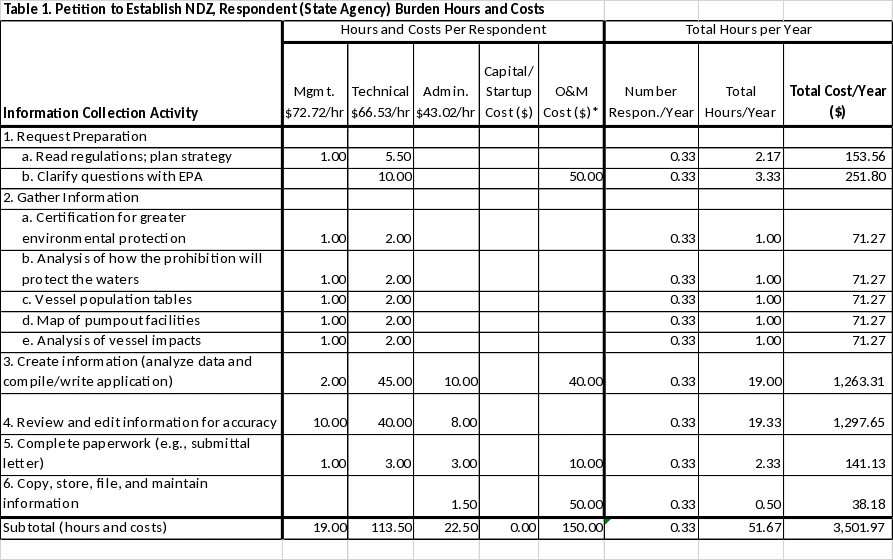
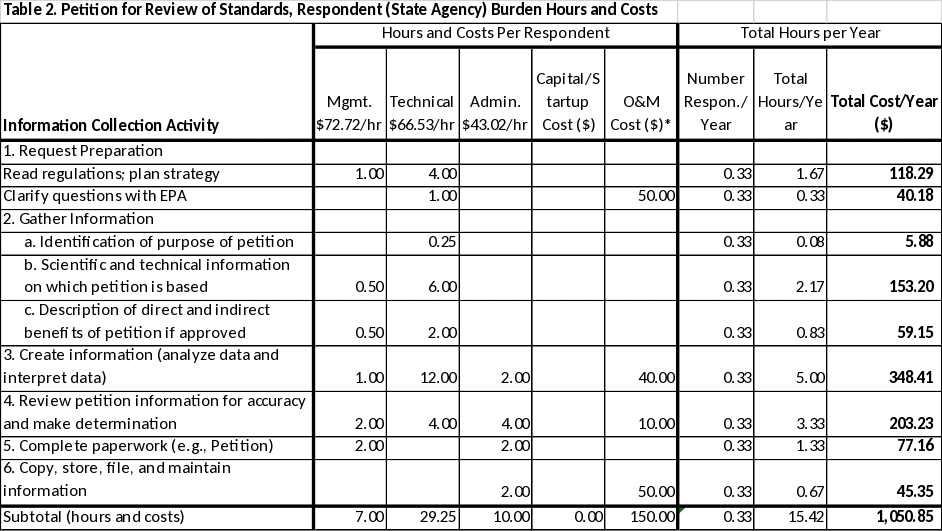
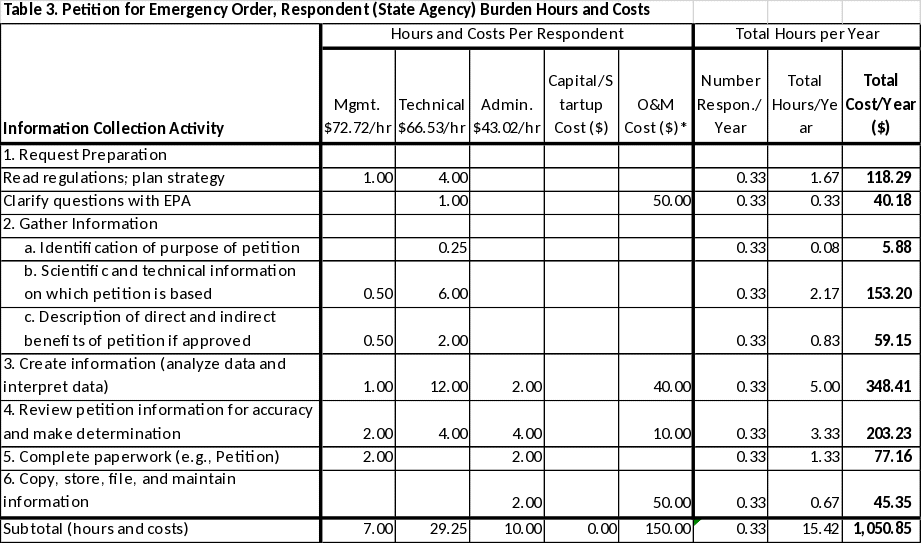
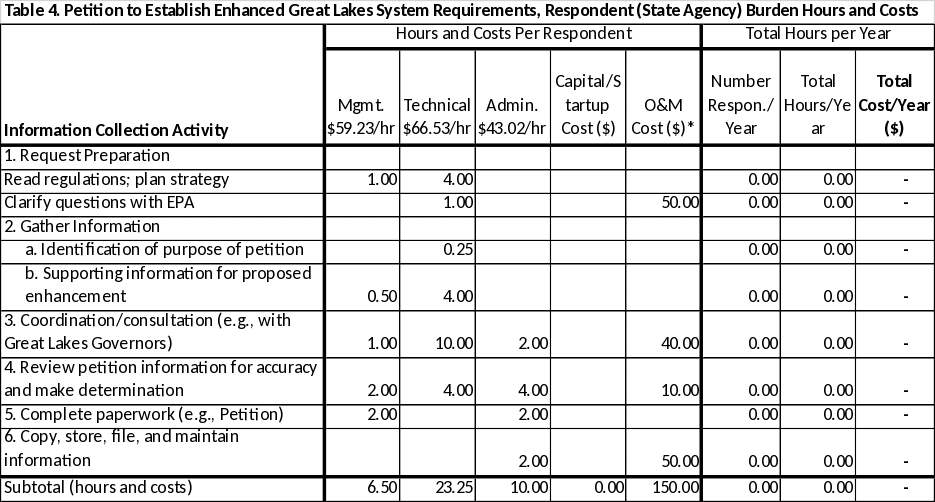
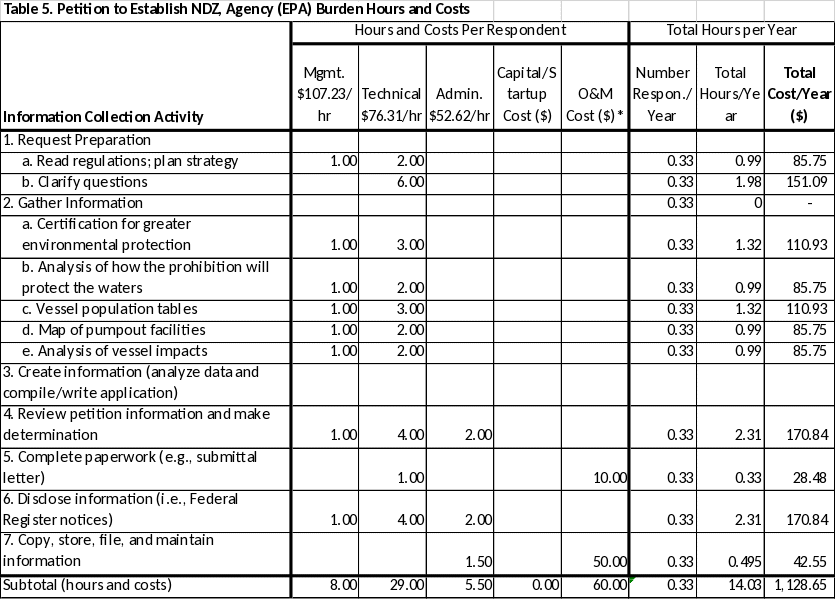
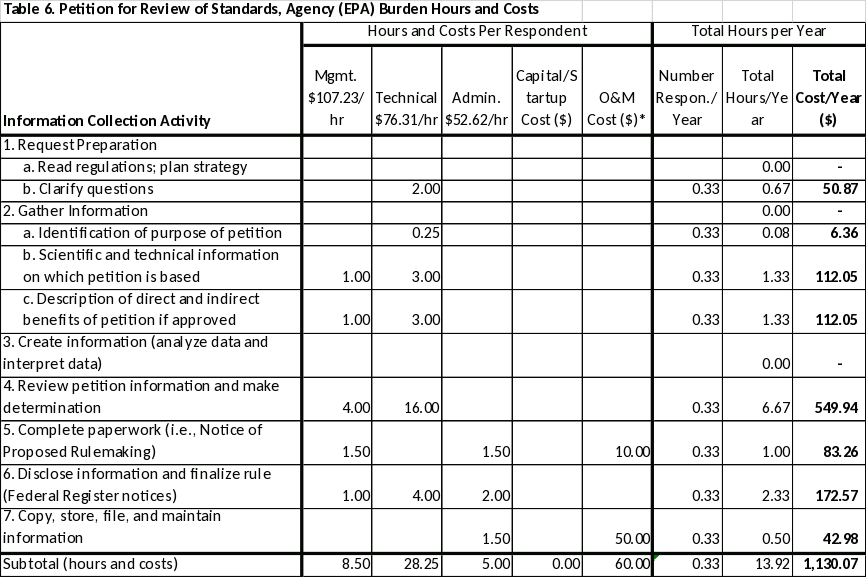
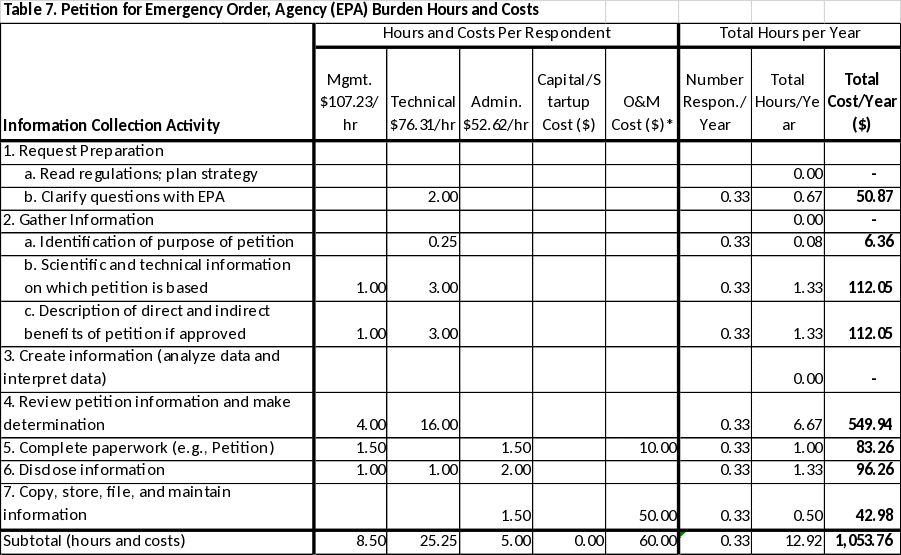
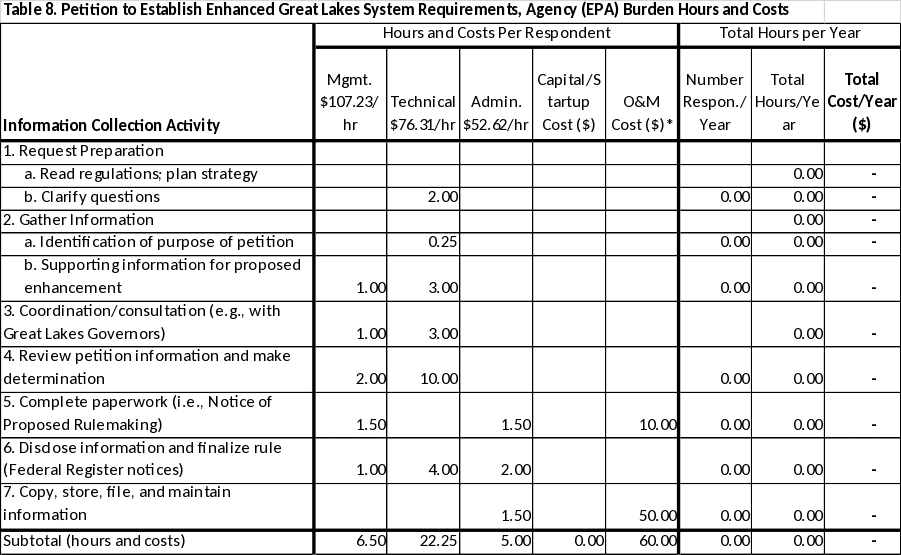


| File Type | application/vnd.openxmlformats-officedocument.wordprocessingml.document |
| File Title | 18Q Supporting Statement Instructions_draft |
| Author | McGrath, Daniel |
| File Modified | 0000-00-00 |
| File Created | 2024-10-31 |
© 2025 OMB.report | Privacy Policy